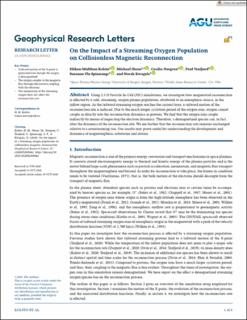| dc.contributor.author | Kolstø, Håkon Midthun | |
| dc.contributor.author | Hesse, Michael | |
| dc.contributor.author | Norgren, Astrid Elisabet Cecilia | |
| dc.contributor.author | Tenfjord, Paul | |
| dc.contributor.author | Spinnangr, Susanne Flø | |
| dc.contributor.author | Kwagala, Norah Kaggwa | |
| dc.date.accessioned | 2021-08-02T12:34:50Z | |
| dc.date.available | 2021-08-02T12:34:50Z | |
| dc.date.created | 2021-01-19T12:02:55Z | |
| dc.date.issued | 2020 | |
| dc.identifier.issn | 0094-8276 | |
| dc.identifier.uri | https://hdl.handle.net/11250/2765862 | |
| dc.description.abstract | Using 2.5-D Particle-In-Cell (PIC) simulations, we investigate how magnetotail reconnection is affected by a cold, streaming, oxygen plasma population, attributed to an ionospheric source, in the inflow region. As the tailward streaming oxygen reaches the current layer, a tailward motion of the reconnection site is induced. Due to the much longer cyclotron period of the oxygen ions, oxygen cannot couple as directly into the reconnection dynamics as protons. We find that the oxygen ions couple indirectly by means of impacting the electron dynamics. Therefore, a demagnetized species can, in fact, alter the dynamics of the reconnection site. We see further that the reconnection rate remains unchanged relative to a nonstreaming run. Our results may prove useful for understanding the development and dynamics of magnetospheric substorms and storms. | en_US |
| dc.language.iso | eng | en_US |
| dc.publisher | AGU | en_US |
| dc.rights | Navngivelse 4.0 Internasjonal | * |
| dc.rights.uri | http://creativecommons.org/licenses/by/4.0/deed.no | * |
| dc.title | On the Impact of a Streaming Oxygen Population on Collisionless Magnetic Reconnection | en_US |
| dc.type | Journal article | en_US |
| dc.type | Peer reviewed | en_US |
| dc.description.version | publishedVersion | en_US |
| dc.rights.holder | Copyright 2020 The Authors | en_US |
| dc.source.articlenumber | e2020GL089462 | en_US |
| cristin.ispublished | true | |
| cristin.fulltext | original | |
| cristin.qualitycode | 2 | |
| dc.identifier.doi | https://doi.org/10.1029/2020GL089462 | |
| dc.identifier.cristin | 1874210 | |
| dc.source.journal | Geophysical Research Letters | en_US |
| dc.identifier.citation | Geophysical Research Letters. 2020, 47(22), e2020GL089462 | en_US |
| dc.source.volume | 47 | en_US |
| dc.source.issue | 22 | en_US |

